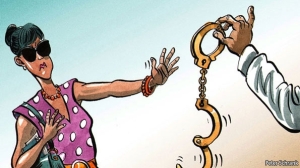本文是关于婚姻制度的思考。俺头一次学习纽约时报的写作风格,虽然本人对这种装b的文风不感冒,不过不装不行啊,现在大家都喜欢装b,你不装,那你“不装”这个行为本身就是在装b了。
—题记。
At 8:30 in the morning, a long line has already formed in front of the main entrance of the Queens County Clerks Office in Kew Gardens, New York.
Even the chilly spring wind in New York could not blow away the joy written on everyone’s face. The soon-to-be couples, holding each other’s hands, anxiously waiting to enter the courtroom. Once they enter the room, all they need to do is pay a $35 fee and they will be officially married before a county clerk. It is such a divine moment for the men and women outside.
Although, they still have to wait in line.
On the other hand, to get a divorce in New York is much more complicated. Couples have to go to a court and lawyers are usually needed. Until 2010, New York recognized divorces only upon fault-based criteria, which means: you don’t need reason to get married, but you do need one to get a divorce.
According New York Department of Health’s vital statistics records, in 2010, a total of 67,051 couples got married in New York City, while in the same year, 27,833 couples got divorced. Nearly half of the number of marriages! People are rushing into marriage while at the same time people are rushing out.
Ancient Greek philosophers described the phenomenon of marriage as a “bird cage”: “birds outside want to get in, while birds inside want to get out.” It seems to be just as true today, only that more and more birds are leaving while less ones are getting in.
According to a new Pew Research Center nationwide survey, done in association with TIME, using data from the U.S. Census Bureau, the marriage rate in the United States has been dropping steadily for half a century. Barely half of the adults in the United States choose to get married today.
Marriage is on the decline, worldwide. Asian Research Institute reports that a third of all Japanese women 30 or above were single in 2010 and half or more of those will probably never marry. In Taiwan, 37% of all women aged 30-44 were single in 2010 and in HK, 27%. So few Korean women choose to marry today that men call it “marriage strike”.
While less people choose to marry today, divorce rate has reached a historical high. In many western countries, nearly half of the new marriages end in divorce.
Something within the marriage system, which is based, in theory on a lifetime commitment, seems to have gone wrong, I believe.
Erwin J. Haeberle is a German social scientist. He has studied American’s marriage system and concluded that American marriage laws are “outdated” and “can no longer reflect all of social changes today”.
In his book “The Sex Atlas”, he proposed various possibilities of future marriage, such as: open marriage, temporary marriage, trial marriage, marriage in two steps, non-monogamous marriage, polygamy, group marriage and same-sex marriage.
Some of these proposals have already become laws in some countries. Same sex marriage and trial marriage, for example, which people, particularly in the West, have done informally since the 1960s. Even potential demolition of marriage has somehow also begun in the form of allowing looser social relationships, such as the “domestic partnership” in New York or similar “lifelong partnership” in France and Germany, to be defined as marriage.
In 2010, a new law was proposed in Mexico City, allowing marriages to automatically expire after two years if couples choose not to renew it. A similar law is also in discussion in the Philippines and a few other countries.
Bitter Lawyer, a website that jokes about the “funny laws,” wrote:
“Under a proposed “marital opt-out agreement,” couples will determine the time limit of their union, with two years being the minimum term and “’til death do us part” presumably being a bit longer term.”
Lawmakers from Mexico seemed have bet much hope in the bill. Lizbeth Rosas Montero, the bill’s co-author believes the bill would “reduce the divorce rate and lessen the burden on the court system”.
But if divorce is so troublesome, why do people want to get married in the first place?
To find the answer, I decided to do a research on the institution of marriage.
Friedrich Engels seemed to be the first one who had explained the institution of marriage in writings. In his famous book “The Origin of the Family, Private Property and the State”, Engels pointed out that family came after the industrialization of society from the rise of inheritable wealth, where women were considered as property of men. Lewis H. Morgan and a few other people’s work further support and complement Engels theory.
Independent scholar Christopher Dawson wrote, “The family, as we understand it, owes nothing to biological or sexual causes, but is an economic institution arising from the development of private property and the consequent domination of women by men.”
But Engels’ theory is almost 200 years old and perhaps outdated since the decline of marriage rate started only recently. What do experts think of marriage today?
I turned to history professor of Columbia University, Richard Bulliet.
Professor Bulliet is the author of several history books, among which the famous: “The Earth and Its People: a Global History”. The book has over 1000 pages and has explained the origin and evolution of human being in a great detail.
Professor Bulliet was very busy so I decided to interview him through email. Several days after I sent him my questions, he wrote me back:
“This is a very difficult question”, he wrote, “hence my delay in writing about it”.
“When Engels were writing, Europe conceived of marriage is a sanctified binary relationship that fixed in law crucial matters of paternity and transmission of property. But we no longer have that today. Marriage in the United States is waning, and less formalized parenting situations are gaining in frequency. Even though property still exists. Most American children today are born outside of a binary marriage relationship, and about half of the binary marriage relationships end in divorce”.
After explaining the origins of marriage, he concluded that Engels’s “property theory” of marriage was based on “partial, inadequate, and often mistaken knowledge” that the theory is nothing but an “imaginary sequence” which cannot be verified historically.
Modern marriage, after removing property as the core consideration, leads in two directions: one concerns parentage and another concerns a “pair-bonding relationship”, he said.
“Is marriage necessary for parentage in a contemporary society?”
Bulliet thinks “no”.
“Fostering, adoption, surrogate parentage, and systems of collective upbringing can in some instances be effective substitutes. A homosexual couple can be loving and responsible parents even if they cannot marry. Artificial insemination, egg implantation, and other ways of generating children without DNA derived from the married couple can produce loving and supportive homes. This includes, of course, undisclosed non-marital pregnancies in which a husband raises another man’s child without knowing it. Inheritance in these instances proceeds along lines associated with the marriage institution, but one can imagine other possibilities.”
“Its link with parenting may continue to diminish just as its link with property has already diminished. Marriage may eventually evolve into an institution that primarily attests to a desire for lifelong pari cohabitation”, he concluded.
By “desire for lifelong pari cohabitation”, did he mean “love”? Professor Bulliet left an open ending here.
Love is for sure related to marriage. I could see love was written on the faces of the couples waiting to enter the Queens country clerk’s office in Kew Gardens. I could see love from the faces of brides and grooms on their weddings. I have also seen love from the hugs and kisses of grandpa and grandma on their 40-year anniversary of marriage. Love indeed seems to be the reason for contemporary marriage.
But can love last as long as marriage that “till death do us apart?”
Helen E. Fisher, an anthropologist at Rutgers University who is recognized by the BBC as one of the world’s best-known researchers in studying behavior of love, defines love as a passion of “chemicals.” In her book, Why We Love: The Nature and Chemistry of Romantic Love, she wrote, “The human passion of romantic love does not last long.”
On the other hand, Elaine Hatfield, a psychology professor at the University of Hawaii who has been studying love since the 1960s, says, “Passionate love provides a high, like drugs, but you can’t stay high forever.”
If love cannot last through marriage, why weren’t people breaking up in the past?
Natalie Bennett, then deputy editor of the UK newspaper Guardian Weekly, believes she has found the answer to the question.
Bennett did a research and found that the current average length of marriage before divorce in the UK—11.5 years—is roughly equivalent to the average length of marriage in early modern Europe. Given the historic death rates, the median length of the partnership or marriage in the old times before one or the other died, usually, the woman of childbirth would probably have been about that.”
It seems that I accidentally found the reason of high divorce rate in today’s society, that is, short life span of love does not match the longer life span of people. It appears to be quite true, thinking that true lovers would never consider a divorce and divorce only happens when love depletes.
If love cannot support marriage through its full contract length of “until death do us apart”, what reasons do we have now to keep the institution of marriage today? Is marriage a necessary element for modern society?
To find the answers, I further researched to see if there is any reason for marriage to exist.
Since love is the blood of marriage and love is what makes marriage live, I first researched to see if modern marriage guarantees love. In the end, love can live without marriage, but marriage cannot live with love.
The results that I found were not very supportive to my assumption. It seems marriage displays no benefits for love; instead, marriage often becomes a barrier to love, especially when the marriages are arranged, a practice that is very common in China, India, Pakistan and many Muslim countries today.
In 2011, 19-year-old Siddqa and 25-year-old Khyyam of Afghanistan were sentenced to death by stoning after they tried to elope away from their arranged marriages. A bystander captured the execution on video and it shocked the whole world. The unfortunate young couple is just one example of victims of the modern marriage system. For them, marriage did not protect love; it destroyed it.
If marriage does not protect love, does it enhance love? Not really.
Following the wedding, often the idea that “now you are mine” leads couples to lose interest in each other. We hear wives complain all the time about how their husband become less enthusiastic and passionate after they got married, while men complain that women stop trying as hard and put on weight.
Other roles that marriage plays in today’s society are far from positive.
Marriage may cause confusion for older single people who were socialized to think that they have to have been married in order to be thought of as “normal.” People also complain about married couples getting bigger tax refunds then two single people, even when they do exactly the same work.
But to many people, the most frustrating aspect of modern marriage is perhaps the irreversibility of marriage. Once one is “married,” the best result he or she can get is “divorced.” Say goodbye to “single” forever.
The existence of the institution of marriage has revoked more and more controversy in today’s society. While many elderly people still have faith in marriage system today, young people seemed to be losing enthusiasm in it.
For an on-the-ground view of the issue, I interviewed students of marriageable age, for their sense of how they see the institution.
Yuki, 22, a student at the Earth Institute of Columbia University said, “the purpose of marriage is to prove its inappropriateness and then you can get a divorce.”
Liu, 22, another Earth Institute student from China said, “marriage is for green card.”
Their classmate, Huihui was quite serious with my questions and answered, “marriage is necessary for the purpose of bearing the next generation. It is a kind of social responsibility”.
In fact, Pew Research Center found that more than 40% Americans younger than 30 consider marriage passe.
“They see it as an obsolete social environment,” said D’Vera Cohn, a Pew researcher.
“In the 1950s, if you weren’t married, people thought you were mentally ill,” said Andrew J. Cherlin, a Johns Hopkins University sociologist who studies families. “Marriage was mandatory. Now it’s culturally optional.”





